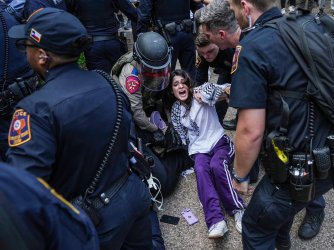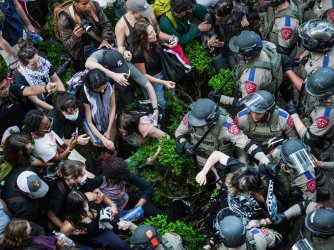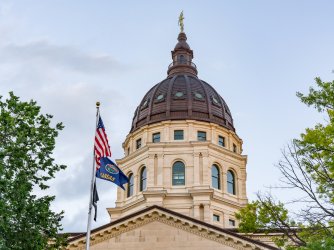Table of Contents
Is there a free speech “crisis” on campus?

Earlier this month, the explainer website Vox featured an article titled “Data shows a surprising campus free speech problem: left-wingers being fired for their opinions.” This article is the latest in a growing number of efforts to push back against the supposedly common idea that free speech on college campuses is in “crisis.” Vox cites an analysis by Canadian political scientist Jeffrey Sachs earlier this year, which is among the most cited of these efforts. The Vox article joins recent pieces by NBC News and GQ, as well as additional coverage by other authors in Vox and The Washington Post.
FIRE is the nation’s foremost organization dedicated to defending student and faculty expressive rights, and it certainly would make our job easier if this perception of a free speech crisis on campus were really as widespread as some of our critics seem to believe. Yet while it may be tempting to shout “crisis” from the rooftops, FIRE doesn’t do that. Indeed, when asked whether there is a crisis of free speech on campus, our answer has long been that the question is more complicated than one might think.
It depends on what you mean by “crisis”
If a “crisis” requires that things be obviously much worse today than they were in the recent past, well, we probably don’t have that kind of crisis. This is in no small part because free expression on campus has been in bad shape for a very long time. Back in early 2016, in fact, FIRE President and CEO Greg Lukianoff wrote about this in an essay for Cato Unbound with the rather prosaic title of “Campus Free Speech Has Been in Trouble for a Long Time.” His main points are the same ones we would make today.
First, speech codes never went away, and in fact became endemic to academia (a point Greg made way back in 2010). Yet thanks in large part to vigorous advocacy by FIRE, the percentage of schools with blatantly unconstitutional or illiberal “red light” speech restrictions on their books has steadily dropped in recent years, from 74 percent in 2009 to 32 percent in 2018. The free speech lawsuits filed against schools—at least 72 since 1989, by our internal count—have been overwhelmingly favorable for the plaintiffs and have also helped push colleges in the right direction. Still, 32 percent is still far too high; 0 percent is the appropriate number. And when you factor in the percentage of schools with only slightly less restrictive “yellow light” policies, the percentage of schools with restrictive speech codes on the books is still above 90 percent. That’s unacceptable.
Second, federal regulations have had the effect of pushing schools towards restricting more speech rather than less. In order to avoid expensive and intrusive federal investigations into alleged violations of Title IX or other anti-discrimination statutes, schools have taken a very expansive view of what sort of expression might constitute discriminatory harassment, sometimes on direct federal orders. That’s how you get the University of Oregon to slap a female student with five student conduct charges for making a four-word joke—you implicitly threaten to make a federal case out of it if it doesn’t.
If you are looking to find a crisis, though, Greg’s final point is probably the place to go. As he points out, since around 2013–2014, more students appear to be open not only to supporting restrictions on speech, but to using their own speech and advocacy to try to silence their opponents rather than engage with them. Greg, joined by NYU psychologist Jonathan Haidt, will be exploring this further in their upcoming book, The Coddling of the American Mind, due out on September 4.
Disinvitations are not the be-all, end-all of campus censorship
Much has been made of campuses’ disinvitations of famous speakers on ideological grounds, since they are a highly visible and quantifiable symptom of hostility towards dissenting ideas on campus. (FIRE has done its part for awareness in this area; our Disinvitation Database is regularly cited by allies and critics alike.) And invited speakers are indeed important to campus dialogue—a FIRE/YouGov survey last year revealed that an amazing 64 percent of students had changed an opinion on a topic thanks to hearing a speaker from outside of campus. But to focus on disinvitations, which don’t even account for the people who never get invited in the first place, is to focus on only a single result of hostility towards dissenting views—not the whole picture.
“We all know who’s at fault here, right? The other guys!”
Complicating matters, free speech has become a culture war issue, which means that people are up in arms about it on both sides. While good for awareness, this is almost certainly bad for those who want to try to get a real sense of what is going on. Look at the Vox headline, for example: “Data shows a surprising campus free speech problem: left-wingers being fired for their opinions.” I have no doubt that many people would, and do, find this surprising—but it’s actually exactly what people should expect. Once you abandon principle and accept a system where some people’s rights are worth more than others, everyone’s claim to that right is weakened. If you don’t concern yourself too much when academia persecutes a right-leaning John McAdams or James Enstrom, you make it easier for the same to happen to the left-leaning David Guths and Randa Jarrars and George Ciccariello-Mahers and Lisa Durdens. (And, of course, vice versa. FIRE came to the defense of all the aforementioned faculty members.) The power to deny rights is a double-edged sword, and is too powerful and tempting to go unused.
FIRE has been explaining that the denial of free speech, due process, and related rights on campus is a problem for everyone, regardless of viewpoint, for the past 19 years. And that’s fine: paying attention to campus speech issues isn’t a full-time job for most people like it is for us at FIRE. But it also means that most people haven’t had 19 years to advocate for reform, investigate the situation, and simply think every day about the problem. We have, and we know that there’s a problem on campus.
There’s more to come...
So, what’s the real story (at least from FIRE’s perspective) on the situation for campus free speech? Is it a “crisis” or not? In the coming days, FIRE will address this question in a series of posts that look at the situation from a number of different angles, using the best information we have (some of which only we have), so that you can decide for yourself whether or not there’s a crisis of free speech on campus—and, given what’s at stake for our free society, whether that’s even the right question to ask.
Recent Articles
FIRE’s award-winning Newsdesk covers the free speech news you need to stay informed.

Texas tramples First Amendment rights with police crackdown of pro-Palestinian protests

Here’s what students need to know about protesting on campus right now

Kansas takes a stand for intellectual freedom
